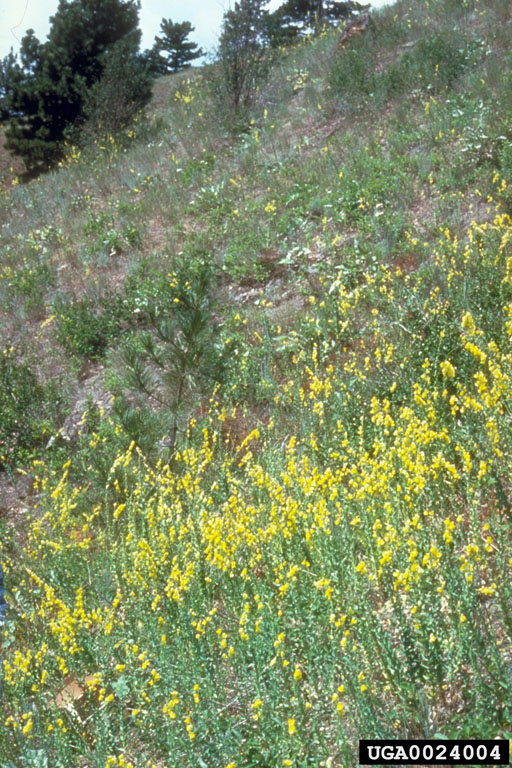Photos: Flowers Leaves Seeds Fruits Full Plant Infestation
Scientific/Common Name: Dalmatian toadflax (Linaria dalmatica and Linaria genistifolia) also known as "butter and eggs" (this name more often used for yellow toadflax), "Jacob's ladder", and "wild snapdragon". (2)(7)
Description/Variation: Dalmatian toadflax is an herbaceous perennial native to the Mediterranean region. This short-lived purrennial plant is a member of the figwort family and was brought to the west coast of North America around 1874 as a decorative plant in gardens. It was cultivated frequently because of its showy flowers, and therefore was spread widely across the world from its native habitat. (2)(5)

Stems/Leaves: Dalmatian toadflax had a woody, stocky base, with both short prostrate stems, and puright floral stems. The more stems this plant has, the more likely it is to survive and reproduce. Its leaves are pale green, waxy, and heart-shaped, about 1 to 3 in. long in length, that clasp the stem. (1)(3)(4)(9)
Fruits/Seeds: Seedlings generally will emerge in spring and form rosettes that are usually under 2 inches high. The seeds are produced in a 1/2 in pod, and are winged. A mature plant can produce up to 500,000 seeds during its life-span. Some seeds will live underground (in the soil seed bank) for up to 10 years, and then emerge in the spring when the soil becomes warm enough. The fruits are 2-celled capsules containing many irregular seeds. (1)(3)(5)(8)
Flowers: The plant's flowers are 1 in. long, bright yellow in color, and are often tinged with orange or red. They have swollen corolla-tubes that flare into two lips; the upper lip is two-lobed while the lower one is three-lobed. They look much like a snapdragon flower. (1)(5)(6)
Reproduction/Distribution: The plants begin regrowth as soon as the soil warms in early spring. It spreads by horizontal or creeping roots, and by seeds that are distributed to other regions by the wind, birds, and other animals (including us humans!). This plant can quickly colonize cultivated ground, primarily sandy or gravelly soils, but can develop in a wide range of conditions. (3)(5)(10)
Life-span: The average life span of a Dalmatian toadflax plant is three years. (5)
Montana Infestation/ History: Dalmatian toadflax is an aggressive weed that will take over forage in pastures, rangelands, and wildlands. It competes with native grasses and wildflowers, which eventually reduces cattle and other wildlife's food. The plant can be found along roadsides, in abandoned lots and fields, in gravel pits, and in clearings. This weed is found at elevations from 5,000 feet to over 10,000 feet. It's also toxic to many animals including cattle. (6)(7)(10)
Prevention/Control:
Chemical: Herbicides can be effective but require repeated treatments at high rates. Tordon, Plateau, or Telar are all herbicides used to control Dalmation toadflax. They should be sprayed when the plant is flowering or in the fall. You need a good surfactant to get the herbicide to stick to the thick, waxy leaves for the herbicide to work. (6)(7)
Biological: Insects or disease organisms are used to control the weed, but biological control is likely to be very limited because of the close relationship between these weedy species and the ornamental types of the snapdragon. (6)
Mechanical (Cultural): Dalmation toadflax can be pulled, as long as all lateral roots are removed as well. (8)
Useful Links:
1) http://www.oneplan.org/Crop/noxWeeds/nxWeed05.htm
2) http://www.mtweed.org/Identification/PROJECT/project.html
3) http://www.mtweed.org/Identification/PROJECT/Newsletter/newsletter.html
4) http://www.agf.gov.bc.ca/cropprot/weedguid/dalmtoad.htm
5) http://www.nwcb.wa.gov/
6) http://www.ext.nodak.edu/extpubs/plantsci/weeds/w1239w.htm
7) http://www.ext.colostate.edu/PUBS/natres/03114.html
8) http://www.fs.fed.us/pnw/bmnri/weeds/weed_toadflax.html
9) http://www.blm.gov/education/weeds/really_wanted/dalmation.html
10) http://www.weedsbc.ca/weed_desc/dalmatian.html
By: Kara V., WHS Student. 1/01.
Updated by: Emily Foster, WHS student, 2/24/06
Back to Weed ID mtwow.org HOME